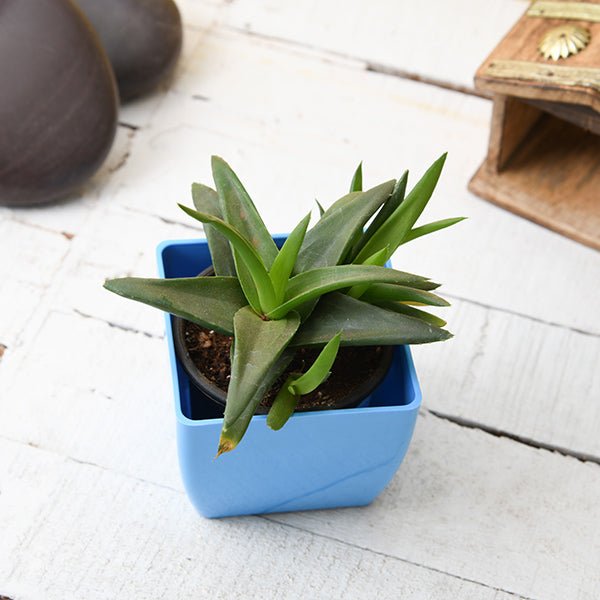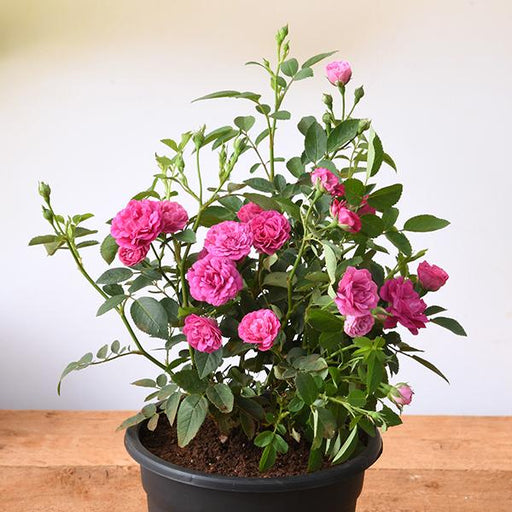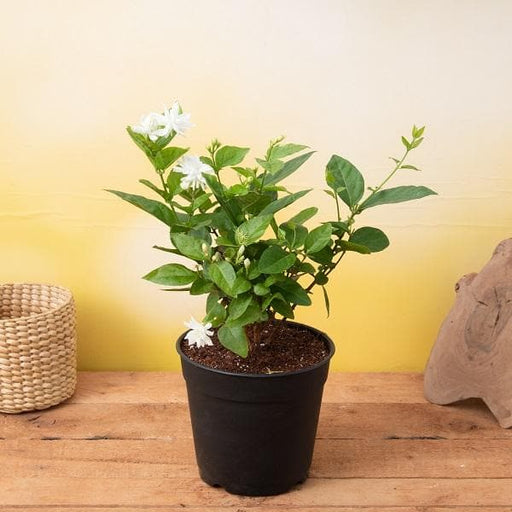
Alworthia Black Gem - Succulent Plant
(MRP Inclusive of all taxes)
- Shipping ₹79 for entire order
- Dispatch in 7 days
- Country of origin: India

(MRP Inclusive of all taxes)
 Save 29%
Save 29%
Air Purifier Money Plant with Pot The Air Purifier Money Plant, also known as Pothos or Epipremnum aureum, is a stunning indoor plant that...
View full details
 Save up to 15%
Save up to 15%
Peace Lily, Spathiphyllum - Plant The Peace Lily, scientifically known as Spathiphyllum, is a stunning houseplant celebrated for its elegant white...
View full details
 Save 25%
Save 25%
Jasminum sambac, Mogra, Arabian Jasmine - Plant Jasminum sambac, commonly known as Mogra or Arabian Jasmine, is a fragrant flowering plant...
View full details
 Save 18%
Save 18%
Combo Constituents Includes the Parijat Tree (Night-Flowering Jasmine), a culturally significant plant with fragrant flowers. Description The Pari...
View full details
 Save 25%
Save 25%
Miniature Rose, Button Rose (Any Color) - Plant The Miniature Rose, also known as the Button Rose, is a charming and compact flowering plant that ...
View full details Save 25%
Save 25%
Damascus Rose, Scented Rose (Any Color) - Plant The Damascus Rose, also known as Rosa damascena, is a timeless symbol of beauty and romanc...
View full details
 Save 17%
Save 17%
Beautiful Fragrant Mogra, Arabian Jasmine Plant with Pot The Beautiful Fragrant Mogra, also known as Arabian Jasmine (Jasminum sambac), is...
View full details Save 15%
Save 15%
Pack of Vermicompost and Neem Cake for House Plants Transform your indoor garden with our premium Pack of Vermicompost and Neem Cake, spec...
View full details
Pack of Plant Growth and Flower Boosters Unlock the full potential of your garden with our Pack of Plant Growth and Flower Boosters! This ...
View full details Save 38%
Save 38%
Combo of Jeevamrut and Neem Raksha for Easy Growth and Protection of Houseplants Transform your indoor garden with our exclusive combo of ...
View full details Save 22%
Save 22%
Plant Nutrients Kit (Pack of 16) for a Healthy Garden Transform your garden into a lush paradise with our Plant Nutrients Kit, featuring 1...
View full details Save 16%
Save 16%
Combo of Top Plant Fertilizers Elevate your gardening game with our exclusive Combo of Top Plant Fertilizers, featuring two bags of premiu...
View full details Save 24%
Save 24%
Pack of 4 Additives to Make Soil Healthy and Nutrient Rich Transform your garden into a thriving ecosystem with our Pack of 4 Additives de...
View full details Save 30%
Save 30%
Transform your gardening experience with our premium Combo of Perlite and Vermiculite. This unique blend is designed to enhance soil aeration and ...
View full details Save 27%
Save 27%
Combo of 2 Vermicompost and Cocopeat - Enrich Your Soil Naturally! Transform your garden into a thriving ecosystem with our Combo of 2 Ver...
View full details
 Save 35%
Save 35%
Best 6 Plants for Perfect Indoor Garden Transform your living space into a lush oasis with our curated collection of the Best 6 Plants for a...
View full details
 Save up to 50%
Save up to 50%
Mini Succulent Garden Pack Transform your space with our Mini Succulent Garden Pack, featuring a delightful collection of 4 any variety beautiful s...
View full details
 Save 30%
Save 30%
5 Best Fragrant Plants Transform your garden or indoor space into a fragrant paradise with our curated selection of the 5 Best Fragrant Plants. Th...
View full details
 Save 24%
Save 24%
Set of 2 Bonsai Looking Grafted Adeniums Transform your indoor or outdoor space with our exquisite Set of 2 Bonsai Looking Grafted Adenium...
View full details Save 45%
Save 45%
Top 4 Die Hard Succulents Pack Transform your indoor or outdoor space with our Top 4 Die Hard Succulents Pack, featuring a curated selecti...
View full details
 Save 30%
Save 30%
5 Best Indoor Plants Pack Transform your living space into a lush oasis with our '5 Best Indoor Plants Pack.' This carefully curated collection fe...
View full details
 Save 25%
Save 25%
Set of 4 Evergreen Air Purifier Plant Pack Transform your indoor space into a lush, green oasis with our Set of 4 Evergreen Air Purifier Pla...
View full details| SrNo | Item Name | Qty |
|---|---|---|
| 2 | Alworthia Black Gem Succulent Plant in 3 inch (8 cm) Pot | 1 |
| 3 | 3.3 inch (8 cm) Square Plastic Planter with Rounded Edges (Blue) | 1 |
The Alworthia Black Gem is a stunning succulent that captivates with its dark, almost black leaves adorned with striking white markings. This hybrid plant, a cross between Aloe and Gasteria, thrives in various environments, making it a perfect addition to any indoor or outdoor garden. Its unique appearance and low maintenance requirements make it a favorite among succulent enthusiasts and collectors alike.
What sets the Alworthia Black Gem apart is its ability to adapt to different light conditions while maintaining its vibrant color. This resilient plant not only adds a touch of elegance to your space but also purifies the air, contributing positively to your indoor environment. With its compact size, it fits perfectly on windowsills, desks, or as part of a larger succulent arrangement.
Special features of the Alworthia Black Gem include its drought tolerance and ability to thrive in well-draining soil. This plant is not only visually appealing but also environmentally friendly, as it requires minimal water and care, making it an excellent choice for sustainable gardening.
If you think caring for a plant is as easy as watering it and hoping for the best, think again! The Alworthia Black Gem is a diva in the succulent world. It thrives on neglect, but don’t let that fool you; it still requires a sprinkle of love and attention. Keep it in bright, indirect sunlight, and let the soil dry out between waterings. Overwatering is its nemesis, so channel your inner minimalist and resist the urge to drown this beauty.
Want to multiply your succulent army? Propagating the Alworthia Black Gem is like playing plant matchmaker. Simply take a leaf or offset, let it callous over for a day or two, and then plant it in well-draining soil. With a little patience and the right conditions, you’ll have new little gems sprouting up in no time. Just remember, they don’t come with a manual, so be prepared for some trial and error!
Size matters, especially when it comes to the Alworthia Black Gem. This succulent is a compact powerhouse, typically reaching about 6 to 12 inches in height. It’s perfect for those who want a statement piece without sacrificing too much real estate. Whether you place it on your desk or as a centerpiece, its striking dark leaves will have everyone asking, “What’s that fabulous plant?”
The Alworthia Black Gem is a bit of a light snob. It prefers bright, indirect sunlight, which means it’s not a fan of harsh, direct rays. Think of it as the Goldilocks of succulents—too much sun, and it’ll scorch; too little, and it’ll sulk. Find that sweet spot, and you’ll be rewarded with a lush, happy plant that’s the envy of all your friends.
When it comes to soil, the Alworthia Black Gem is a bit of a connoisseur. It craves well-draining soil that allows its roots to breathe. A cactus mix or a blend of potting soil with perlite will do the trick. Avoid heavy, moisture-retaining soils like the plague, or you’ll find your succulent drowning in its own misery.
Watering the Alworthia Black Gem is an art form. It’s all about timing and technique. Allow the soil to dry out completely before giving it a drink, and when you do, make it a thorough soak. Think of it as a spa day for your plant—just enough to refresh, but not so much that it feels like it’s swimming.
Fertilizing the Alworthia Black Gem is like giving it a little pick-me-up. During the growing season, a diluted succulent fertilizer will keep it thriving. But don’t go overboard; this plant prefers a light touch. Too much fertilizer can lead to leggy growth, and nobody wants a plant that looks like it skipped leg day at the gym.
The Alworthia Black Gem is generally pest-resistant, but that doesn’t mean it’s invincible. Keep an eye out for mealybugs and aphids, those pesky little party crashers. If they show up uninvited, a gentle spray of insecticidal soap or neem oil will send them packing. Remember, a healthy plant is a happy plant, so regular check-ups are key!
Good news for pet owners! The Alworthia Black Gem is non-toxic to cats and dogs, making it a safe addition to your home. You can enjoy its beauty without worrying about your furry friends turning into little plant ninjas. Just keep it out of reach if your pets have a penchant for nibbling on greenery—better safe than sorry!
The Alworthia Black Gem isn’t just a one-hit wonder; it has a few fabulous relatives. From the classic green varieties to those with striking variegation, there’s a succulent for every taste. Each variety brings its own flair, so why not collect them all? Your plant shelf will look like a succulent fashion show in no time!
Beyond its stunning looks, the Alworthia Black Gem offers a plethora of benefits. It’s a natural air purifier, helping to cleanse your indoor environment while adding a touch of greenery. Plus, caring for plants has been shown to reduce stress and boost mood. So, not only will you have a gorgeous plant, but you’ll also be cultivating happiness—talk about a win-win!
Alworthia Black Gem is a charming succulent that boasts dark, glossy leaves with striking white markings. This little gem is a hybrid between Aloe and Haworthia, making it a low-maintenance superstar. Perfect for those who want to add a touch of drama to their plant collection without the fuss of high-maintenance greenery.
Caring for Alworthia Black Gem is as easy as pie! Place it in bright, indirect sunlight and water it only when the soil is completely dry. This succulent thrives on neglect, so don’t drown it in love. Just remember, less is more when it comes to watering—think of it as a desert vacation!
Alworthia Black Gem loves a well-draining soil mix, ideally a cactus or succulent blend. Think of it as a sandy beach for your plant—no soggy shoes allowed! You can also mix regular potting soil with sand or perlite to create the perfect drainage situation. Your succulent will thank you for the sandy getaway!
Watering Alworthia Black Gem is like a game of hide and seek—only water when the soil is dry! Typically, this means every 2-3 weeks, but it depends on your climate. In winter, cut back even more. Remember, overwatering is the enemy, so let your plant enjoy its dry spell!
Absolutely! Alworthia Black Gem is an indoor superstar, thriving in bright, indirect light. It’s like the introverted friend who prefers cozy indoor gatherings over wild parties. Just ensure it gets enough light and avoid overwatering, and you’ll have a happy little succulent that brightens up your space!
Good news for pet parents! Alworthia Black Gem is non-toxic to cats and dogs, making it a safe choice for your furry friends. So, you can enjoy its beauty without worrying about your curious companions nibbling on its leaves. Just keep it out of reach to avoid any accidental plant parties!
While Alworthia Black Gem is generally pest-resistant, keep an eye out for mealybugs and aphids. These little party crashers can ruin your succulent’s vibe. If you spot them, a gentle wipe with a cotton swab dipped in alcohol will send them packing. Prevention is key—keep your plant clean and happy!
Propagating Alworthia Black Gem is like making mini versions of your favorite dessert! Simply take offsets or leaves and let them dry for a day or two. Then, plant them in well-draining soil and water sparingly. With a little patience, you’ll have new little gems to share or keep for yourself!
Alworthia Black Gem prefers a cozy climate, thriving in temperatures between 65°F and 80°F. It’s not a fan of frost, so keep it indoors during chilly months. Think of it as a succulent diva that enjoys a warm, sunny spot—just like you on a beach vacation!
Yes, Alworthia Black Gem can bloom, but don’t hold your breath! When it does, expect tall flower spikes with tubular blooms that are quite the sight. However, it’s more about the foliage than the flowers with this succulent. So, enjoy the leaves and consider any blooms a delightful bonus!
With proper care, Alworthia Black Gem can live for many years—think of it as the tortoise in the race of life! These resilient succulents can thrive for a decade or more, bringing joy and greenery to your space. Just give it the right conditions, and it’ll be your long-term plant buddy!
You can find Alworthia Black Gem at local nurseries, garden centers, or online plant shops. Just make sure to check the reviews—nobody wants a plant that arrives looking like it just survived a hurricane! Happy hunting for your new succulent companion, and may your plant shopping be fruitful!